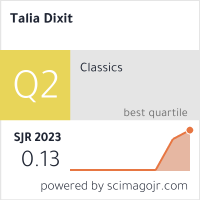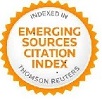Retorica militare fra tradizione protrettica e pensiero strategico
Palabras clave:
Discursos protrépticos, Ilíada, Procopio, Rhetorica militaris, Estrategia bizantina, Siriano Magister, TucídidesResumen
La Rhetorica militaris, il logikon meros del compendio di Siriano Magister, si pone come tappa tanto originale quanto isolata del processo evolutivo del genere protrettico. Se i prodromi sono ravvisabili già nell’Iliadeomerica, le Storie tucididee rappresentano anche per tale ambito un esempio insuperato per gli storici militari di età successive, tra questi soprattutto Procopio. L’opuscolo, il cui impianto è esemplato sulle teorie esposte nel corpus attribuito ad Ermogene di Tarso, coniuga i motivi protrettici con una riflessione strategica che nell’etàbizantina assume una fisionomia matura: in guerra le istanze relazionali ed emozionali possono essere più importanti dello scontro in armi.
Descargas
Referencias
ALBERTUS, J. (1908), Dieπαρακλητικοίin der griechischen und römischen Literatur, Strassburg: Trübner.
BALDWIN,B.(1988), “On the Date of the AnonymousΠερὶ στρατηγικῆς”, Byzantinische Zeitschrift 81, 290-293.
BONNOT, G. (1783), De la manière d’écrire l’histoire, Paris: Jombert.
BRAUN, H. (1885) Procopius Caesariensis quatenus imitatus sit Thucydidem (Diss. Inauguralis [...] ab amplissimo philosophorum ordine Erlangensi), Erlangae: Typis Jungii et filii.
BURGESS, T.C. (1902), Epideictic Literature, Chicago: The University of Chicago Press.
CAGNAZZI, S. (1986), “L’ἀρχαιολογεῖνdi Nicia (Tucidide VII 69,2)”, Athenaeum n.s. 64, 492-497.
CAMERON, A. (1985), Procopius and the Sixth Century, Berkeley-Los Angeles: University of California Press.
CANFORA, L. (1992), “L’agorà: il discorso suasorio”, in G. Cambiano, L. Canfora, D. Lanza (dir.), Lo spazio letterario della Grecia antica. I, La produzione e la circolazione del testo. I, Lapolis, Roma: Salerno, pp. 379-395.
COSENTINO, S. (2000), “The Syrianos’s «Strategikon»: A 9th Century Source?”, Bizantinistica n.s. 2, 243-280.
DAIN, A. (1937), La «Tactique» de Nicéphore Ouranos, Paris: Les Belles Lettres.
____ (1943), Naumachica, Paris: Les Belles Lettres.
ERAMO, I. (2007), “῏Ωἄνδρες στρατιῶται. Demegorie protrettiche nell’Ambrosianus B 119 sup.”, Annali della Facoltà di Lettere e Filosofia dell’Università degli Studi di Bari 50, 127-165.
____ (2008), “Omero e i Maccabei: nella biblioteca di Siriano Μάγιστρος”, Annali della Facoltà di Lettere e Filosofia dell’Università degli Studi di Bari “Aldo Moro” 51, 123-147.
____ (2009), “ ̔Ρωμαῖοι e ῎Αραβες a battaglia? Nota al De re strategica di Siriano Μάγιστρος”, Invigilata Lucernis 31, 95-104.
____ (2010), “Sulla datazione del compendio di Siriano Magister”, in c.d.s. FLEURY, P.(2001),“La flûte, le général et l’esclave: analyse de certaines métaphores rhétoriques chez Fronton”, Phoenix 55, 108-123.
GABBA, E. (1996), Dionigi e la Storia di Roma Arcaica, Bari: Edipuglia (Dionysius and the History of Archaic Rome, Berkeley: University of California Press 1991).
GRUNDY, G.B. (19482, 1948), Thucydides and the History of His Age, I-II, Oxford: Blackwell.
HAMMOND, N.G.L. (1973), “The Particular and the Universal in the Speeches in Thucydides, with Special Reference to that of Hermocrates at Gela”, in Ph.A. Stadter (ed. by), The Speeches in Thucydides. A Collection of Original Studies with a Bibliography, Chapel Hill: University of North Carolina Press, pp. 49-59.
HANSEN, M.H. (1993), “The Battle Exhortation in Ancient Historiography. Fact or Fiction?”, Historia 42, 161-180.
____ (2001), “The Little Grey Horse. Henry V’s Speech at Agincourt and the Battle Exhortation in Ancient Historiography”, Classica et Mediaevalia 52, 95-114.
HARDING, H.F. (1973), The Speeches of Thucydides. With a General Introduction and Introductions for the Main Speeches and the Military Harangues, Lawrence: Coronado Press.
IGLESIAS ZOIDO, J.C. (2000), “¿Se pronunciaron realmente las arengas de Tucídides?: el testimonio de Th. VII, 61-70”, Athenaeum 88, 515-528.
____ (2007), “The Battle Exhortation in Ancient Rhetoric”, Rhetorica 25, 141-158.
____ (2008), “La arenga militar en la historiografía griega: el modelo de Tucídides y sus antecedentes literarios y retóricos”, in Retórica e historiografía: el discurso militar en la historiografía desde la Antigüedad hasta el Renacimiento, Madrid-Cáceres: Ediciones Clásicas-Universidad de Extremadura, pp. 231-258.
JEBB, R. C. (1880), The Speeches of Thucydides, in E. Abbott (ed. by), Hellenica. A Collection of Essays on Greek Poetry Philosophy History and Religion, Oxford-Cambridge: Rivington Press, pp. 266-323.
KAEGI, W. E. (1983), Some Thoughts on Byzantine Military Strategy, Brookline [Mass.]: Hellenic College Press.
____ (1990), “Procopius the Military Historian”, Byzantinische Forschungen 15, 53-85.
KEITEL, E. (1987), “Homeric Antecedents to the Cohortatio in the Ancient Historians”, Classical World 80, 153-172.
KENNEDY, G.A. (1957), “The Ancient Dispute over Rhetoric in Homer”, American Journal of Philology, 78, 23-35.
KÖCHLY, H. – RÜSTOW, W. (1855), Des Byzantiner Anonymus Kriegswissenschaft, nebst einem dreisachen Anhange und den erklärenden Anmerkungen zu den drei Taktikern (Griechische Kriegsschriftsteller, griechisch und deutsch mit kritischen und erklärenden Anmerkungen von H. Köchly und W. Rüstow, II2), Leipzig: Engelmann.
LATEINER, D. (1985), “Nicias’ Inadequate Encouragement (Thucydides 7. 69. 2)”, Classical Philology 80, 201-213.
LEE, D. – SHEPARD, J. (1991), “A Double Life: Placing the Peri Presbeon”, Byzantinoslavica 52, 15-39.
LEIMBACH, R. (1985), Militärische Musterrhetorik. Eine Untersuchung zu den Feldherrnreden des Thukydides, Stuttgart: Steiner.
LONGO, O. (1983), “I discorsi tucididei: uditorio indiviso e scomposizione d’uditorio”, Museum criticum 18, 139-160.
LUSCHNAT, O. (1942), Die Feldherrnreden im Geschichtswerk des Thukydides, Leipzig: Dieterich.
MAZZUCCHI C.M. (1978), “Dagli anni di Basilio Parakimomenos (Cod. Ambr. B 119 sup.)”, Aevum 52, 267-316.
MÜLLER, K.K. (1882), Eine griechische Schrift über Seekrieg, Würzburg: Stuber.
NAVARRO ANTOLÍN, F. (2000), “La Retórica del discurso: la Cohortatio. Tradición clásica y pervivencia”, Cuadernos de filología clásica. Estudios latinos 19, 79-124.
NICOLAI, R. (1999), “Polibio interprete di Tucidide: la teoria dei discorsi”, Seminari romani di cultura greca 2.2, 281-301.
____ (2006), “Polibio e la memoria della parola: i discorsi diretti”, in R. Uglione (a c. di), Scrivere la storia nel mondo antico. Atti del Convegno Nazionale di Studi, Torino, 3-4 maggio 2004, Alessandria: Edizioni dell’Orso, pp. 75-107.
ΠΑΝΑΓΟΠΟΥΛΟΣ, Α. (2006), “ Ἡ Τελευταία Παρακέλευση του Νικία (Θουκυδίδης, 7. 77)in Γ´ ∆ιεθνές Συμπόσιο για τον Θουκυδίδη. ∆ημηγορίες.III International Symposium on Thucydides. The Speeches, Alimos: Sideres, pp. 150-155.
PRITCHETT, W.K. (1994), Essays in Greek History, Amsterdam: Gieben.
____ (2002), Ancient Greek Battle Speeches and a Palfrey, Amsterdam: Gieben.
RANCE, Ph. (2007), “The Date of the Military Compendium of Syrianus Magister (Formerly the Sixth-Century Anonymus Byzantinus)”, Byzantinische Zeitschrift 100, 701-737.
SACKS, K. (1981), Polybius on the Writing of History, Berkeley-Los Angeles-London: University of California Press.
____ (1986), “Rhetoric and Speeches in Hellenistic Historiography”, Athenaeum n.s. 64, 383-395.
SCARDINO, C. (2007), Gestaltung und Funktion der Reden bei Herodot und Thukydides, Berlin-New York: de Gruyter.
SOLMSEN, F. (1954), “The "Gift" of Speech in Homer and Hesiod”, Transactions of the American Philological Association 85, 1-15.
TARAGNA, A. M. (2000), Logoi historias. Discorsi e lettere nella prima storiografia retorica bizantina, Alessandria: Edizioni dell’Orso.
VATTUONE, R. (1978), Logoi e storia in Tucidide. Contributo allo studio della spedizione ateniese in Sicilia del 415 a.C., Bologna: Cleup.
VEGETTI, M. (1975), “Tucidide e la scienza della storia”, in L. Canfora(a c. di), Erodoto, Tucidide, Senofonte. Letture critiche, Milano: Mursia, pp. 158-166.
WEST, M.L. (2007), Indo-European Poetry and Myth, Oxford: University Press.
WESTLAKE, H.D. (1968), Individuals in Thucydides, Cambridge: University Press.
ZUCKERMAN, C. (1990), “The Military Compendium of Syrianus Magister”, Jahrbuch der Österreichischen Byzantinistik 40, 209-224.












